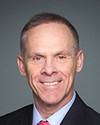Thank you for the invitation.
I'm going to go through the document that was handed out. I'm going to refer to the pages as I go through this so you can follow along.
Page 2 gives a background on the Atlantic Salmon Federation, ASF. I'm not going to go through that because I think we've had members here before.
I'm going to jump right into page 3, and start with that. Our policies and positions are science-based within our organization. We're internationally recognized for our research capabilities. We're in collaboration with local, national, and international partners to address threats to wild Atlantic salmon.
We participate in all kinds of science forums, including working groups, such as the International Council for the Exploration of the Sea, known as ICES, which provides advice to the North Atlantic Salmon Conservation Organization, NASCO.
What I'm going to do over the next few minutes is just focus on two of our research priorities, marine research and aquaculture interactions between wild and farmed salmon.
On page 4, I'm going to start with marine tracking. Mortality rates for Atlantic salmon at sea are double those of the 1970s and 1980s. Mortality in the ocean is one of the largest challenges facing Atlantic salmon today. Comprehensive descriptions of the movement and spatial distribution of individuals at sea are essential in order to understand how animals interact with their environment.
Studying large-scale marine migration and behaviour of fishes has become possible with the development of electronic tags that store information about the environment experienced by the fish. The ASF has been involved with the development of these electronic tags for the past 20 years, working with industry partners to develop these tags, so that we're able to now track fish in the ocean.
Since 2003, we've been using acoustic telemetry to track salmon out of various Gulf of St. Lawrence rivers. Some of the specific objectives for this comprehensive tracking program include expanding our ability to track North American salmon populations in the estuaries, out along the North American coast to Labrador and the coast of Greenland. We're identifying critical habitats and feeding areas in the ocean. We're determining the impact of predators and prey on marine life stages of salmon. We're estimating stage- and area-specific mortality rates. We're correlating the movement of the fish with environmental variables, notably currents and water temperatures. We're exploring climate-driven ecosystem changes.
This project is the most comprehensive marine research being conducted on wild Atlantic salmon globally, focusing on the migration and survival of smolts and kelts. What I mean by kelts is that these are salmon that have spawned, post-spawned salmon. Atlantic salmon can spawn multiple times. These are salmon going back out into the estuary and ocean, reconditioning and coming back to the river. We're tagging and following those fish.
This information is on the watersheds and in the North Atlantic. This project provides the best overall review of what is happening in the estuaries and in the ocean. Understanding ocean distribution and migratory behaviour of wild Atlantic salmon is critical, as it will provide the foundation and parameters of future conservation and restoration efforts in the development of management and conservation strategies.
I'm not going to spend a lot of time on slide 5. We can go back to it if you have questions after. It's a map showing where our areas of focus have been in the Gulf of St. Lawrence. We've been tagging fish, primarily in the Grand Cascapedia, Restigouche, and northwest and southwest branches of the Miramichi since 2003. You can see the number of electronic tags we've put on the animals. Each of these tags track individual fish, so we have information on over 2,500 smolts and over 400 kelts.
We put receiver curtains at the heads of tides, so that we can get a measure of survival of all the fish that we're tagging leaving fresh water. We're putting these curtains at the outer estuaries and bays, the Miramichi Bay, Chaleur Bay, so we can get a measure of survival through the bays and estuaries. You can see, in the Gulf of St. Lawrence, we've got receivers across the Strait of Belle Isle and the Cabot Strait, so we can get a measure of survival through the Gulf of St. Lawrence.
We're also employing satellite tags. I'm going to talk about that.
On slide 6, there are all kinds of things we've been finding out. I'm just going to focus on two or three things today. One is that the survival of the smolts that we've tagged, as they migrate through the freshwater zone in the spring, has been quite high. Once they get into the estuaries and the bay is where the problems start. However, in the estuaries and the bays, we've been finding, and this is Miramichi Bay and Chaleur Bay, that the survival is down to between 60% and mid-seventies, which we think is adequate. However, since about 2011, the survival for Miramichi smolts has dropped dramatically, as they enter the estuary and before they leave Miramichi Bay. Survival is down below 30%, in the mid-twenties. Something is happening to our smolts.
Besides the smolts, we have also been working with DFO tracking striped bass in that system. We have compared the data, overlaying tracks, and we are finding that a lot of the smolts we've been tagging and tracking since 2011 have been consumed by striped bass. Tags that are supposed to be in smolts are now moving like striped bass. We actually have data to show that striped bass are significantly impacting smolt survival through the Miramichi Bay.
Another thing we are finding is that the survival of smolts is quite high through the Gulf of St. Lawrence, which suggests that the big problems are beyond the Gulf of St. Lawrence, once we get out into the Labrador Sea and off the coast of Greenland.
Another tidbit of information is that once the smolts that we are tagging from the different rivers get out in the ocean, they start travelling as one group, schooling together. They are crossing the Strait of Belle Isle—the narrows, the passage zone to the Gulf of St. Lawrence—pretty well together over about a two-week period every year. That's a critical area we have to protect and watch.
That's all I am going to say about sonic tracking right now. There is other information I would be more than happy to share later, but I just want to touch on these subjects.
I want to talk about pop-up tags, the satellite tags we've been using on the post-spawn adult salmon. These tags record water temperature and water depth. We can actually get day-to-day information from these fish. If you look at the map, you can see the track for one particular fish called 136027. It shows you where this fish was on a day-by-day basis. The larger circles represent depths. These fish are diving to a depth of up to 600 metres. Now we are beginning to understand where these larger salmon are on a daily basis, where they are dying, and in some cases what is killing the fish.
Where are we going with this? Based on our time series—we have over 10 years of data right now—we understand trends. One trend I mentioned is the loss of smolts in the Miramichi estuary. We are going to continue focusing on predator-prey interactions, particularly in that estuarial bay, and also looking at cormorants in the Chaleur Bay.
As we identify critical habitat migration zones, we are going to identify what we call “traffic” in those areas, meaning looking at predator-prey interactions and the environmental parameters linking everything together. What we need to do is tag more salmon and track them for greater distances.
In 2016, we plan to pick a river in Labrador and tag smolts there. We plan to start tagging salmon off Greenland and tracking them back to home waters, and we are obviously looking at putting more receiver arrays in the Labrador Sea and off the coast of Greenland.
As far as recommendations go, it is critical for DFO to develop management measures to balance and protect both wild Atlantic salmon and striped bass. Debbie Norton gave a really good overview of this. We want an equilibrium. We aren't against striped bass, but there needs to be a balance.
More federal research and innovation funding is needed in order to expand tracking efforts in the marine environment. This stems from recommendations from the ministerial advisory committee, and also from the Prime Minister's mandate letter to DFO, which says:
Restore funding to support federal ocean science and monitoring programs, to protect the health of fish stocks.... Work with the provinces,...Indigenous Peoples, and other stakeholders to better co-manage our three oceans.
One of the support venues we feel will be helpful is the new Atlantic salmon research joint venture program, which started back in June. We have meetings in Moncton today and tomorrow. I don't mind talking more about this if you want.
Another recommendation is to provide support for the Collaboration for Atlantic Salmon Tomorrow, CAST. I don't know whether you are familiar with it, but CAST is an innovative program of research and improvement projects rolled into a single program, which could serve as a model for other Atlantic salmon rivers with populations at risk. Marine tracking is one component of CAST. I'll leave it there for now on CAST. I certainly don't mind sending information on that at a later point or if questions arise.
One of the things ASF does, as our data comes in, is openly share it with DFO and policy-makers. We do have our data peer-reviewed, but we feel it's important to share the data as we find it so that management decisions can be made in a timely manner.
Over 20 different partnerships have been and are involved with the tracking program.
For the next minute and a half, I am going to switch gears totally and go to salmon aquaculture, really briefly.
A sustainable aquaculture industry will have significant economic value to Canada. For long-term value, the industry must be socially, ecologically, and economically sustainable. However, there are all kinds of significant challenges with interactions between wild and escaped farm salmon. There have been many peer-reviewed research studies on wild and farm salmon interactions, and ASF has been part of many of those publications. We would be more than happy to share those publications with you.
The biggest threats with open-net pen farms are disease, parasites, and escapes. When escapes happen and get into river systems, that's where genetic pollution or genetic introgression occurs. ASF has knowledge and expertise to help address these challenges.
One of the things ASF have been working on is demonstrating the biological, technical, and economic feasibility of land-based, closed containment systems.
I'm not going to get into the next two slides right now. The first one is the Magaguadavic River, located in southwestern New Brunswick, where we have a system in place to monitor wild and escaped farm salmon entering that river. You can see the trends over time. There are 99% of these fish entering the river. These are escaped farm salmon that have no home, meaning the industry is not reporting these fish escaping; we don't know where they're coming from. These fish have introgressed or spawned with wild salmon in the river. There's a paper out that shows that those fish have destroyed the wild population in this particular river.
It's not only in New Brunswick; we see the same problems in Newfoundland. We're finding all kinds of escapes and genetic introgression. You've probably read in the papers that DFO scientists are starting to find that information.
Tens of millions of federal dollars are spent to compensate open-net and salmon aquaculture for losses from diseases like ISA and parasites like sea lice.
There's a lack of transparency when it comes to reporting escapes and the level of disease and parasites. There's a lack of enforcement and accountability by the federal government when it comes to regulations. There's a need for a regional, what I call pan-Atlantic, approach to regulations and farm management practices.
With regard to recommendations, a more consistent approach is needed for regulations and best farming practices throughout Atlantic Canada and the state of Maine. We feel all aquaculture fish should have an external identification marker on them so in the event that they escape and show up in a stream, we can identify that they are indeed aquaculture fish and remove them.
There needs to be more transparency by the salmon aquaculture industry when it comes to reporting escapes, diseases, and parasite levels. More accountability and enforcement is needed by the regulators. More funding is needed for research and development for land-based closed containment.
On the final point, all future salmon aquaculture operations should occur on land.
Thank you for your time.






